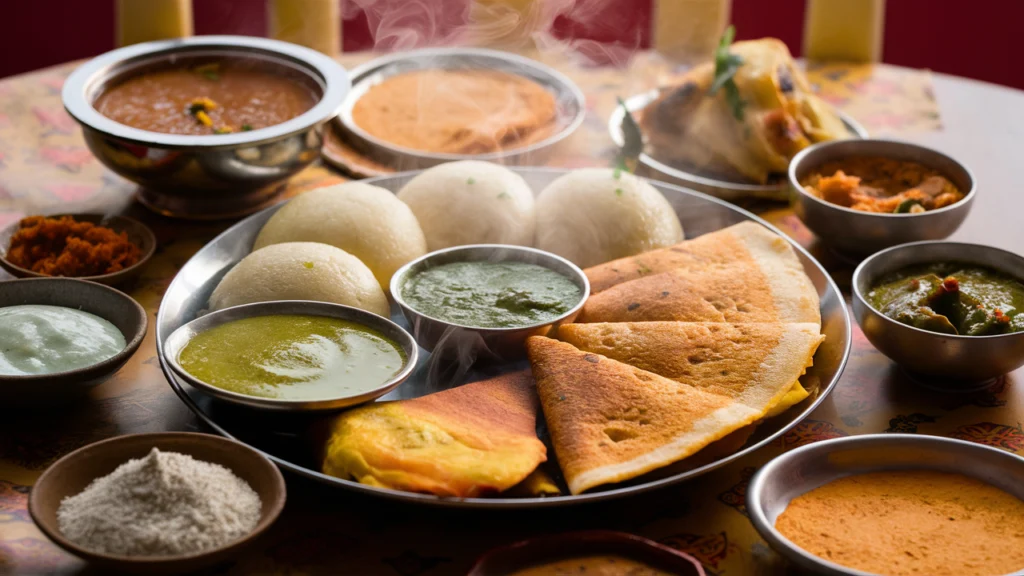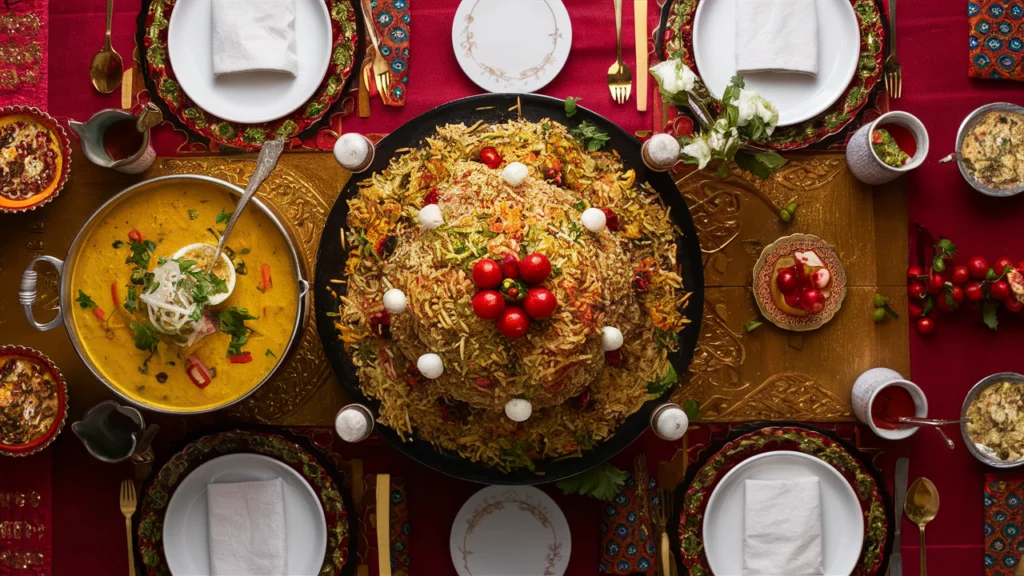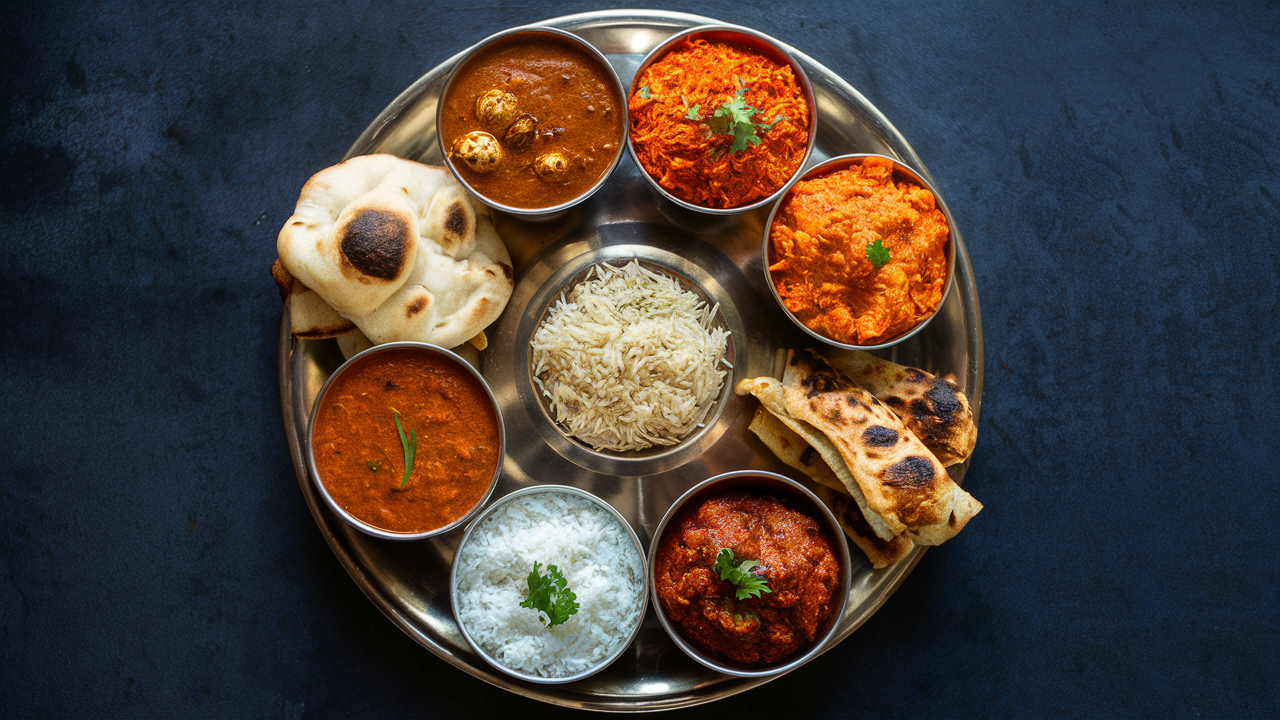Exploring the Vibrant World of Indian Side Dishes
Exploring Indian cuisine unveils a range of side dishes, each with unique flavors and textures. Indian side dishes are more than accompaniments; they are essential parts of the meal that enhance dining. They reveal the country’s vast culinary diversity. Zesty pickles, nourishing dals, fluffy breads, and fragrant rices are as crucial as the main dishes they complement.
Introduction to Indian Side Dishes
Indian cuisine is as diverse as its culture, woven from the countless communities and regions that make up the subcontinent. Each region offers its own specialties, but what binds them are the side dishes that grace their tables. Whether in a simple weekday meal or a lavish festival feast, side dishes play a pivotal role. They balance flavors and provide a full spectrum of nutrients.
The Importance of Rice and Bread in Indian Meals
Rice and Bread: Staples of Indian Cuisine
Rice and bread are the backbones of Indian side dishes, featuring prominently across all regional cuisines. Fluffy, fragrant basmati rice graces festive occasions, while daily breads like roti and naan are staples. These are revered for their versatility, complementing both vegetarian and non-vegetarian dishes.
Delving into Rice Varieties
Exploring Basmati Rice Preparations
Basmati rice stars in dishes like biryani and pulao, thanks to its distinctive aroma. Preparing basmati requires precise measurements and timing. This ensures each grain stays separate and absorbs the flavors of spices and herbs.
Celebrating Diversity in Bread
Diverse Forms of Indian Breads like Naan and Roti
Beyond the simple roti, naan is a culinary art form. It’s often enriched with butter and stuffed with fillings like garlic, paneer, or minced meat. Each bread variety serves as a perfect scoop for gravies or a soft bed for dry, spicy vegetables.
Enhancing Meals with Condiments
The Condiments: Chutneys and Pickles
No Indian meal is complete without the tangy kick of chutneys and the spicy zest of pickles. These condiments are not just side dishes but powerful flavor enhancers that bring meals to life.
Exploring Popular Condiments
Mint Chutney – A Refreshing Accompaniment
Mint chutney, popular throughout India, features a refreshing mix of fresh mint, cilantro, lemon juice, and various spices. It’s especially beloved in the sweltering summers for its cooling properties.
Mango Pickle – A Tangy Delight
Mango pickle, a staple in Indian households, varies from region to region, each adding its own blend of spices and oil. It can transform any subdued dish into a flavor-packed meal.
This opening section introduces the variety and richness of Indian side dishes. It sets the stage for exploring vegetarian delights and regional specialties in upcoming sections. As we proceed, remember that these dishes do more than complement main courses—they narrate stories of regional heritage and culinary evolution.
Vegetarian Delights
India’s vegetarian cuisine showcases the ingenuity and diversity of its cooks. Across the country, vegetables transform into a variety of side dishes that tantalize the palate and nourish the body.
Exploring Popular Vegetarian Sides
From street food stalls to high-end restaurants, vegetarian side dishes are celebrated throughout Indian cuisine. They provide a rich blend of spices, textures, and colors, captivating food lovers everywhere.
Staple Vegetarian Dishes
Aloo Gobi – A Spicy Cauliflower and Potato Mix
Aloo Gobi, a beloved dish featuring potatoes and cauliflower, is sautéed with turmeric, cumin, and coriander. This robust flavor profile stands strong next to more elaborate main courses. It’s a common presence on tables for both everyday meals and special occasions.
Paneer Tikka – Marinated and Grilled Paneer
Paneer Tikka offers a protein-rich option for vegetarians. Chunks of fresh cheese are marinated in spices and yogurt, then grilled until golden. This dish introduces a smoky flavor that’s hard to resist.
Highlighting Lentil-Based Sides
Lentils are a vital part of the Indian diet, cherished for their protein content and culinary versatility.
Dal Tadka – A Flavorful Lentil Curry
Dal Tadka is ultimate comfort food. Yellow lentils are cooked soft, then tempered with mustard seeds, cumin, garlic, and chilies in oil or ghee. This dish complements both rice and bread and is adored across India for its comforting warmth.
Chana Masala – Spiced Chickpeas
Chana Masala features chickpeas in a spicy, tangy tomato-based sauce. The complexity of its flavors, thanks to garam masala, chili, and amchoor, makes it a favorite at gatherings. It’s a fulfilling, nutritious option that satisfies deeply.
Culinary Reflections and Cultural Significance
These vegetarian dishes are not just sides but stars in their own right, celebrated for their vivid flavors and nutritional value. As we explore both traditional and modern interpretations, these dishes reflect India’s regional diversities and cultural histories. At both casual family dinners and festive gatherings, these dishes hold a place of pride on the Indian table, bringing joy and satisfaction to all who partake.
The diversity of India’s geography and culture is mirrored in its regional side dishes. Each region has its own unique flavors and cooking methods, which reflect the local ingredients, climate, and cultural influences.
South Indian Sides

A vibrant display of South Indian side dishes, including a bowl of coconut chutney, alongside a steaming plate of idli and dosa.
South Indian cuisine is renowned for its emphasis on rice, lentils, and an abundance of spices, creating dishes that are both light and flavorful.
Coconut Chutney – A South Indian Staple – Coconut chutney is a fresh, creamy accompaniment made from grated coconut, green chilies, and mint or cilantro. Tempered with mustard seeds and curry leaves, it’s essential for South Indian staples like dosa and idli. This chutney adds subtle sweetness that balances the savory flavors of main dishes.
Sambar, a staple in South Indian households, is a hearty lentil stew enriched with vegetables such as pumpkin, okra, and tomatoes. It’s distinctively flavored with tamarind and a unique spice mixture known as sambar powder, making it a versatile dish enjoyed widely across the region. This dish is not only a favorite side but also a main course, often served alongside rice or idli.
North Indian Sides
North Indian sides are characterized by their rich, aromatic flavors, often involving dairy products and a wider use of dried fruits and nuts.
Indulge in the delightful embrace of Saag Paneer, where velvety paneer dances with a symphony of spiced spinach, crafting a nourishing and soul-soothing culinary masterpiece. It’s a popular choice during the cold months and pairs beautifully with both rice and naan.
These regional dishes offer a glimpse into local culinary practices and tell the story of India’s agricultural and cultural richness. They demonstrate how traditional cooking techniques and local ingredients come together to create beloved dishes nationwide. Each dish, from Punjab’s lush fields to Tamil Nadu’s coasts, carries its own story and flavor, making Indian cuisine a continuous feast for the senses.
Festive and Special Occasion Dishes

Indian festivals and celebrations are times when the culinary landscape truly comes alive. Moments of celebration beckon for culinary creations that weave magic into gatherings, uniting hearts and spirits in joyous harmony.
Festive Side Dishes
In India, festivals transcend mere celebration, evolving into a lavish symphony of tastes, where accompaniments rival the grandeur of the festivities themselves.
Navratan Korma – Nine Gem Curry – Navratan Korma is a luxurious dish combining nine different vegetables, fruits, and nuts in a creamy, subtly sweet sauce. The name reflects the variety of ingredients, each contributing unique textures and flavors. This royal dish is perfect for celebrations.
Biryani – Aromatic Rice Layered with Spices and Meat or Vegetables – Biryani is a quintessential festive dish in Indian cuisine, celebrated for its complex preparation and vibrant flavors. It consists of layers of basmati rice, marinated meat or vegetables, and a rich spice blend, all cooked slowly to blend the aromas perfectly. This sensory feast is commonly served at major celebrations like weddings and religious events.
These festive dishes not only add to the celebratory mood but also showcase the depth of Indian culinary art. Preparing these dishes is often a communal activity that brings families together in the kitchen, with each member contributing to the meal. This shared cooking experience strengthens bonds and enhances the enjoyment of the feast, infusing each bite with flavors and the warmth of family and friends.
As we conclude our exploration of Indian side dishes, from everyday staples to festive treats, it’s clear these dishes are more than just accompaniments. They celebrate life’s flavors, testify to cultural richness, and are central to India’s culinary legacy.
The Art of Spicing in Indian Side Dishes
Indian cuisine is renowned for its masterful use of spices, which not only enhance the flavor and aroma of dishes but also contribute to their health benefits. This section will delve into the art of spicing, which is fundamental to creating the distinct tastes found in Indian side dishes.
Understanding Spice Blends
Essential Spice Blends in Indian Cooking
Spices are the soul of Indian cooking. This subsection will discuss the essential spice blends like Garam Masala, Curry Powder, and Chaat Masala, detailing how each blend is crafted and the dishes they are typically used in.
Spices for Heat and Flavor
Chilies and Peppers: Adding Heat to Indian Dishes
Explore the various types of chilies used in Indian cooking, from the fiery red chili to the milder green chili. This part will explain how different regions incorporate these chilies into their side dishes to enhance depth and heat.
Techniques in Spice Usage
Tempering: Unlocking the Flavor of Spices
Tempering, or tadka, is a cooking technique essential to many Indian dishes. This subsection will describe how spices are heated in oil to release their full range of flavors before being added to dishes. It will cover the common spices used in tempering and the typical dishes that employ this method.
Health Benefits of Indian Spices
Spices with Benefits: Turmeric, Cumin, and Coriander
This part will discuss the health benefits associated with regular spices used in Indian cooking, such as anti-inflammatory properties and digestion aids. It will also explore how these spices are seamlessly integrated into everyday side dishes.
This exploration into the art of spicing in Indian side dishes offers a deeper understanding of the complexity and thoughtfulness embedded in traditional Indian cooking. It not only shows how spices are used to create flavorful dishes but also highlights their integral role in the health and wellness aspects of Indian dietary habits.
FAQs on Indian Side Dishes
As we explore the world of Indian side dishes, several questions often arise, reflecting curiosity and a desire to incorporate these vibrant dishes into everyday meals. Here are some frequently asked questions that can help demystify the preparation and enjoyment of Indian side dishes.
Choosing Light and Refreshing Side Dishes
What are some light side dishes in Indian cuisine?
Indian cuisine features many light side dishes ideal for everyday meals or lighter fare. Dishes like cucumber raita, sprouted mung bean salad, or simple kachumber (cucumber, onion, and tomato salad) are refreshing, easy to prepare, and pair well with spicy main courses.
Easy Preparation of Everyday Sides
How can I make a simple Indian side dish using everyday ingredients?
One of the easiest Indian side dishes to prepare is aloo jeera—potatoes sautéed with cumin seeds. This dish requires just a few ingredients: potatoes, cumin seeds, salt, and a bit of oil. Another quick dish is stir-fried okra with onions and spices, offering a crunchy texture and spicy flavor profile that goes well with both rice and bread.
Ideal Dishes for Social Gatherings
What are the best Indian side dishes for a party?
For parties, Indian side dishes that can be made in large quantities and are universally loved include paneer butter masala, vegetable samosas, and tandoori broccoli. Each offers a unique flavor and can be prepared ahead of time, making them perfect for gatherings.
Vegan-Friendly Indian Sides
Which Indian side dishes are suitable for vegan diets?
Many Indian side dishes are naturally vegan, making them a wonderful choice for those following a plant-based diet. Dishes like baingan bharta (smoked eggplant mash), rajma (kidney beans in a tomato base), and masoor dal (red lentil curry) are hearty, flavorful, and free from animal products.
Storing and Reheating Tips
How do I store and reheat Indian side dishes?
Most Indian side dishes can be stored in the refrigerator for up to three days in airtight containers. To reheat, use a microwave or stovetop until the dish is thoroughly warmed. For dishes like dal or curries, adding a little water while reheating can help maintain the consistency.
These FAQs guide newcomers and seasoned enthusiasts alike, enhancing their skills and enjoyment of Indian side dishes. Whether preparing a quick weekday meal or a lavish festive spread, these answers offer practical insights for culinary exploration.
Conclusion
Indian side dishes are a delightful and essential part of the meal, offering an array of flavors that enhance the main course and ensure a balanced diet. From the everyday staples to the festive specials, these dishes represent the geographical and cultural diversity of India. Each dish not only satiates hunger but also tells a story of regional traditions, making every meal a new adventure. As we bring our exploration to a close, let’s carry forward the joy of cooking and sharing these wonderful dishes, embracing the rich culinary heritage of India.
